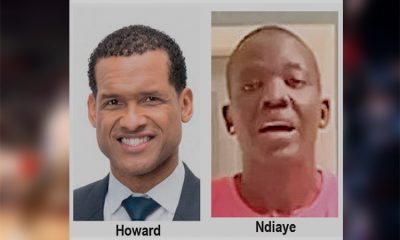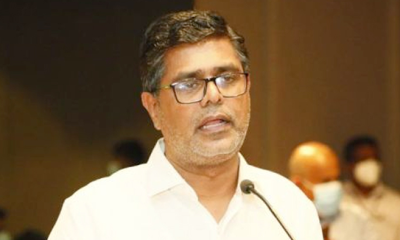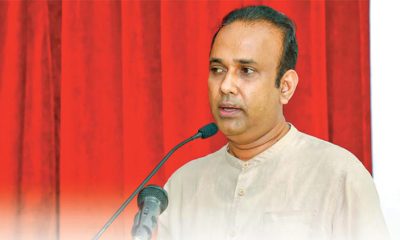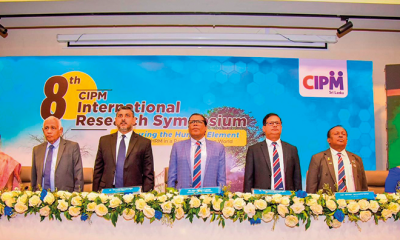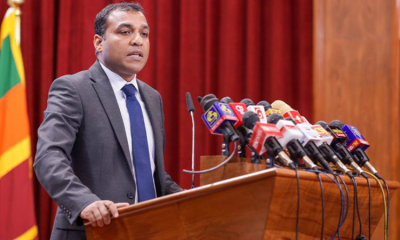Features
Has Israel a Right to Exist?
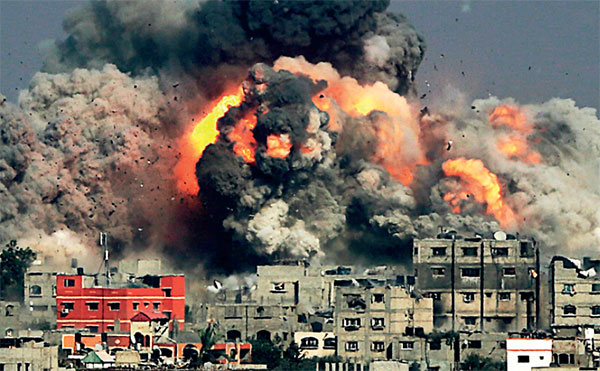
by Gamini Seneviratne
Over 50 years ago in the aftermath of what is miscalled a six-day “war” through which the heavily armed Israeli armed forces slaughtered tens of thousands of Palestinian civilians and appropriated vast tracts of their land, I wrote “Draft for a Lyrical Ballad” (1968) part of which is given below. It was also a period marked by Robert Kennedy’s battles against Lyndon Johnson and the assassination of that Kennedy as well. It also refers to the twin agitations that shake the world and confront the West today.
America, you’re like me, a tired balloon
Looking up into the sky
On a clear, cold night
Waiting for all human sounds to die.
With the unremitting aid of the principal war mongers on this planet, the USA, Israel has acquired and used against unarmed people a whole array of the most obscene weaponry developed by Man (the caps serves to distinguish that entity from humankind)
In his essay of December 26, 2009, (Information Clearing House) “And What Rough Beast Slouches Towards Gaza? Operation Cast Lead and the Dismembering of a People”, Vincent Di Stefano places before the world some particulars of Israel’s criminal attacks on the people of Palestine. A few particulars follow:
Twelwe years ago Israel already had 180,000 heavily armed regular troops in their “defence” forces, 140,000 conscripts, 4,300 impenetrable Merkava battle tanks, 10,000 light tanks and armoured cars, 500 missile-laden fighter jets, 1,340 helicopters, three submarines, three destroyers and smaller warships. And the full might of Israeli military force was projected into the tiny space of Gaza during the three-week period from December 27, 2008 to January 18, 2009. (Further details of what the so-called Israeli-Arab ‘wars’ have meant for the people of Palestine were included in my note of 2006 that follows below).
And right now in the midst of (or, perish the thought, in support of?) the carnage being visited on the Palestinians, US President Biden has offered them over $700 million worth of military hardware. Oh, and yes, he has also offered via USAID, a sum of $ 10 million to Palestine. To be channeled through Israel. Naturally. Biden, in whom people located hopes for humanitarian governance has, after all, done no more than confirm that America has no shame.
Let us look at what the engagement of the rulers of America (its military-industrial coalition) with Israel translates into. In February 2009, investigative journalist Conn Hallinan was to describe Gaza as “Death’s Laboratory.” Israel’s new weapons had caused injuries never before seen in the hospitals of Gaza. Many of these were the result of the widespread use of a new class of weapons called Dense Inert Metal Explosive (DIME). These were initially developed by the US Air Force and scientists from the University of California’s Lawrence Livermore Laboratory in 2000.
DIME weapons consist of a high explosive core around which is wrapped powdered tungsten alloy in a carbon fibre container. On detonation, the tungsten sprays out explosively over a ten-meter radius shredding everything in its field. The resultant injuries are truly shocking. Norwegian doctor Mads Gilbert commented: “The muscles are sort of split from the bones, hanging loose, and you also have quite severe burns. . . . Those inside the perimeter of this weapon’s power zone will be torn completely apart. We have seen numerous amputations that we suspect have been caused by this.”
Here follows my note of 15 years ago on The Holocaust in Palestine.
In his Foreword to “The Little Drummer Girl”, John Le Carre reports that in Israel he was repeatedly assured that the “Palestinians are not a people.” What were they then? “A leftover rabble of peasants and layabouts whose only task for two thousand years was to keep the Jewish homeland ticking over until its rightful owners returned.”
That such was far from being the case may be gathered from the following: These are the words of the best-known British explorer of Arabia, Wilfred Thesiger. He was writing in the 1940s, around the time the Zionist ‘state’ was being set up: “I went to the ‘Empty Quarter’ with a belief in my own racial superiority, but in their tents I felt like an uncouth, inarticulate barbarian, an intruder from a shoddy and materialistic world”. How many in the White House, the State Department, the US Congress would understand such words, grasp such realities?
In a thumbnail account of how Israel has acted in that enterprise in the 1970s, Le Carre writes, “Israeli jets bombed the crowded Palestinian quarter in Beirut on the pretext that it was intended ‘to destroy the leadership’, – “though there were no leaders at all among the several hundred dead, unless, of course, there were future leaders among the many children killed.”
They obviously feel that they can get away with this savage treatment of the inhabitants of Palestine in their own land. Israel, in short, is a rogue state built on a violent process of encroachment into Palestine. ‘Legitimacy’ for its operations is traced to a sanction received from yet other intruders: the British and the French. One must begin the story of Israel with a look at the legitimacy of those who ‘sanctioned’ its creation. The so-called ‘Balfour Declaration’ (the caps there, some may think, give it some kind of legality) was no more than a personal letter of one paragraph from Balfour to his friend and creditor, Rothschild.
The most generous account by a Lankan of the Jewish intrusion into Palestine, now a totally unbridled invasion, was published 70 years ago in the ‘Ceylon Daily News’ by its Editor-in-Chief, H A J Hulugalle, an experienced and even-handed commentator. The substance of his report was that “The Jews of the world are concentrating on the gradual buying up of Palestine”. One such purchase, of 16,000 acres of a swamp that yields the water for agriculture in the Huleh valley, was made despite the protests of the Palestinians. It was bought for 200,000 English pounds off a young ‘absentee landlord’ domiciled in Syria, whose interest in the land was not in his fellow Arabs but in the waterfowl for his table. The ‘compromise’ imposed by the British occupiers of Palestine required the Jews to drain the land and render it malaria free; ‘in return’, the Palestinians were to have their land reduced by two-thirds of it! Those were relatively early days.
When Jewish immigration began in earnest in the late 19th century, (long before ‘the holocaust’ they keep talking about), there were only about 15,000 Jews in Palestine. In 1893 the Arabs comprised roughly 95 percent of the population. Even when Israel was founded, over fifty years later, Jews were only about 35 percent of Palestine’s population and owned seven percent of the land. ‘The Palestinian Problem’ today, as it has been for many decades, is that the Jews want as much of the land as they can lay their hands on, the ports, the sites sacred to Christianity and Islam – plus, of course, ALL the water that over the centuries had sustained the people of Palestine and Jordan.
Ben-Gurion wrote in 1941 that “It is impossible to imagine general evacuation [of the Arab population] without compulsion, and brutal compulsion.” In 1947-48, when Jewish forces drove up to 700,000 Palestinians into exile, Ben-Gurion had told Nahum Goldmann, president of the World Jewish Congress, “If I were an Arab leader I would never make terms with Israel. That is natural: we have taken their country. . . . We come from Israel, but two thousand years ago, and what is that to them? There has been anti-Semitism, the Nazis, Hitler, Auschwitz, but was that their fault? They only see one thing: we have come here and stolen their country. Why should they accept that?”
The current (i.e. in 2006) Zionist leader, Ehud Olmert, came to power on an explicit promise to unilaterally set Israel’s “permanent borders”. The ‘package’ that he took to Washington included, in return for $10 billion he asked for (and received), a plan for the Zionists to withdraw from many smaller settlements – at least 17 in the first phase – in the West Bank and move most of the people in them to larger blocks that they ‘expect to annex’. The man also made it clear that “It will be only a civilian disengagement, not a military disengagement,” The Israeli army will remain in the bits of land the settlers are being moved out of.
Let us look, very briefly indeed, that history being so extensive – at just what the Zionists did. What they continue to do, under cover of the government of the USA, and therefore with apparent impunity is a ‘breaking story’ that may soon explode in their collective face.
The creation of Israel in 1947-48 involved explicit acts of ethnic cleansing, including executions, massacres, and rapes by Jews The Israeli Defence Force (IDF) also murdered hundreds of Egyptian prisoners-of-war in both the 1956 and 1967 “wars”. In 1967, it expelled between 100,000 and 260,000 Palestinians from the newly conquered West Bank and drove 80,000 Syrians from the Golan Heights. Following its invasion of Lebanon in 1982 it also directed the massacre of 700 innocent Palestinians at the Sabra and Shatila refugee camps. During the First Intifida (1987-1991), the IDF distributed truncheons to its troops and encouraged them to break the bones of Palestinian protestors. The Swedish “Save the Children” organization estimated that “23,600 to 29,900 children required medical treatment for their beating injuries in the first two years of the Intifida,” with nearly one-third sustaining broken bones. The same proportion of the beaten children were aged ten and under.” Israel’s response to the Second Intifida (2000-2005) was even more violent: The IDF fired one million bullets in the first days of the uprising. Future Prime Minister Yitzhak Shamir openly argued that, “Neither Jewish ethics nor Jewish tradition can disqualify terrorism as a means of combat”.
After the victory of Hamas, in an open general election, in late January, Israel withheld $50 million a month in Palestinian customs and tax receipts, though it continues to pay Israeli companies $5.5 million a month from those receipts for the water and electricity used by the Palestinians.
Israelis are often touted as being the epitome of bravery (almost on par with George W Bush – seen, once, in dim light on an aircraft carrier hundreds of miles away on his ‘visit to the troops in Iraq’; the George Bush who, for the two days he spent in India and Pakistan, hunkered down, respectively, in a fort off Delhi and in Islamabad in the US Ambassador’s residence, heavily guarded within a vast expanse of streets emptied of people).
What do the Israelis in fact do? Israel is using men who have been conscripted to slaughter the Palestinians. Such men aren’t out there ‘fighting for Israel’s right to exist’. Their heart is not in butchering innocents; – their energies are focused on remaining unhurt themselves, no matter how many innocents they murder. Hence the commanders of the Israeli army are committed to guaranteeing that none of the conscripts will be in danger of injury, much less death.
In “Hiding Behind Civilians’ (New York Times, 22 June, 2006), Haim Watzman, who had served as an Israeli infantry reservist in the West Bank in the 1980’s and 90’s, and authored “Company C: An American’s Life as a Citizen-Soldier in Israel”, wrote, “Soldiers who had to raid a house or patrol a dangerous stretch of road would grab a nearby civilian and place him in front of them. This civilian had no function other than to protect Israeli soldiers.” Though Watzman says that he has “Never met a soldier who thinks armies ought to be able to maim and kill civilians with impunity,” and that “The practice was not a grassroots initiative. It was an army policy, handed down to soldiers by their superior officers,” he also points out that when the Israeli Supreme Court banned the use of such human shields, (just nine months ago), “many in the army felt they had been robbed of a tool that made their jobs safer, and which helped the commanders protect the lives of their soldiers.”(! ! !)
What have the great warriors of Israel put in its place? Bulldozers. Instead of entering a house behind a human shield, Israeli soldiers turn the house into rubble. Watzman concludes: “Morality in combat is not just an abstract principle. It is an element of an army’s strength. If the safety of soldiers becomes the standard according to which an army designs its missions, an army that does not take risks will be easily beaten by an opponent that does. It’s essential for a society to demand that its army observe moral standards, even if the price to be paid is that more soldiers will be killed.” Tell that to Olmert, – who has “vehemently denied that there was any Palestinian “humanitarian crisis”, adding that, “We wouldn’t allow one baby to suffer one night because of a lack of dialysis,” – or tell it to the marines.
Let’s take a look at them ‘in action’. After warplanes knocked out half of Gaza’s electricity and pounded sonic booms over houses, Israeli tanks, hunkered down inside southern Gaza at the airport on Wednesday, (last week) reported the New York Times.
The impact of this, presumably humanitarian assault (which continues as you read this), is that: “Repeated sonic booms are wreaking the havoc they have wrought before: repeated sonic booms are smashing windows, sending children screaming into the arms of terrified adults, old people collapsing with heart failure, pregnant women collapsing with spontaneous abortions. Mass terror, despair, desperate hoarding of food and water. And no radios, television, cell phones, and no way to get news of how long this nightmare might go on.”
That is from Virginia Tilley’s latest report, as are the following.
“As food in the refrigerators spoils, the only remaining food is grains. Most people cook with gas, but with the borders sealed, soon there will be no gas. When family-kitchen propane tanks run out, there will be no cooking. No cooked lentils or beans, no humus, no bread – the staple Palestinian foods, the only food for the poor. (And there is no firewood or coal in dry, overcrowded Gaza.)
“And, a grimmer fact: no water. Gaza’s public water supply is pumped by electricity. The taps, too, are dry. No sewage system. Word is that the electricity is out for at least six months. The Gaza aquifer is already contaminated with sea water and sewage, due to over-pumping (partly by those now-abandoned Israeli settlements) and the grossly inadequate sewage system. To be drinkable, well water is purified through machinery run by electricity. Otherwise, the brackish water must at least be boiled before it can be consumed, but this requires electricity or gas. And people will soon have neither.
“If cholera breaks out, it will spread like wildfire in a population so densely packed and lacking fuel or water for sanitation.” Over a million people, – yes, people like you and me, – are trapped in that Gaza that the Zionists salivate for. “They are hunkered in their homes listening to Israeli shells, while facing the awful prospect, within days or weeks, of having to give toxic water to their children that may consign them to quick but agonizing deaths.”
That is the Israel that has the effrontery to demand its “right to defend itself”.
Features
The heart-friendly health minister

by Dr Gotabhya Ranasinghe
Senior Consultant Cardiologist
National Hospital Sri Lanka
When we sought a meeting with Hon Dr. Ramesh Pathirana, Minister of Health, he graciously cleared his busy schedule to accommodate us. Renowned for his attentive listening and deep understanding, Minister Pathirana is dedicated to advancing the health sector. His openness and transparency exemplify the qualities of an exemplary politician and minister.
Dr. Palitha Mahipala, the current Health Secretary, demonstrates both commendable enthusiasm and unwavering support. This combination of attributes makes him a highly compatible colleague for the esteemed Minister of Health.
Our discussion centered on a project that has been in the works for the past 30 years, one that no other minister had managed to advance.
Minister Pathirana, however, recognized the project’s significance and its potential to revolutionize care for heart patients.
The project involves the construction of a state-of-the-art facility at the premises of the National Hospital Colombo. The project’s location within the premises of the National Hospital underscores its importance and relevance to the healthcare infrastructure of the nation.
This facility will include a cardiology building and a tertiary care center, equipped with the latest technology to handle and treat all types of heart-related conditions and surgeries.
Securing funding was a major milestone for this initiative. Minister Pathirana successfully obtained approval for a $40 billion loan from the Asian Development Bank. With the funding in place, the foundation stone is scheduled to be laid in September this year, and construction will begin in January 2025.
This project guarantees a consistent and uninterrupted supply of stents and related medications for heart patients. As a result, patients will have timely access to essential medical supplies during their treatment and recovery. By securing these critical resources, the project aims to enhance patient outcomes, minimize treatment delays, and maintain the highest standards of cardiac care.
Upon its fruition, this monumental building will serve as a beacon of hope and healing, symbolizing the unwavering dedication to improving patient outcomes and fostering a healthier society.We anticipate a future marked by significant progress and positive outcomes in Sri Lanka’s cardiovascular treatment landscape within the foreseeable timeframe.
Features
A LOVING TRIBUTE TO JESUIT FR. ALOYSIUS PIERIS ON HIS 90th BIRTHDAY

by Fr. Emmanuel Fernando, OMI
Jesuit Fr. Aloysius Pieris (affectionately called Fr. Aloy) celebrated his 90th birthday on April 9, 2024 and I, as the editor of our Oblate Journal, THE MISSIONARY OBLATE had gone to press by that time. Immediately I decided to publish an article, appreciating the untiring selfless services he continues to offer for inter-Faith dialogue, the renewal of the Catholic Church, his concern for the poor and the suffering Sri Lankan masses and to me, the present writer.
It was in 1988, when I was appointed Director of the Oblate Scholastics at Ampitiya by the then Oblate Provincial Fr. Anselm Silva, that I came to know Fr. Aloy more closely. Knowing well his expertise in matters spiritual, theological, Indological and pastoral, and with the collaborative spirit of my companion-formators, our Oblate Scholastics were sent to Tulana, the Research and Encounter Centre, Kelaniya, of which he is the Founder-Director, for ‘exposure-programmes’ on matters spiritual, biblical, theological and pastoral. Some of these dimensions according to my view and that of my companion-formators, were not available at the National Seminary, Ampitiya.
Ever since that time, our Oblate formators/ accompaniers at the Oblate Scholasticate, Ampitiya , have continued to send our Oblate Scholastics to Tulana Centre for deepening their insights and convictions regarding matters needed to serve the people in today’s context. Fr. Aloy also had tried very enthusiastically with the Oblate team headed by Frs. Oswald Firth and Clement Waidyasekara to begin a Theologate, directed by the Religious Congregations in Sri Lanka, for the contextual formation/ accompaniment of their members. It should very well be a desired goal of the Leaders / Provincials of the Religious Congregations.
Besides being a formator/accompanier at the Oblate Scholasticate, I was entrusted also with the task of editing and publishing our Oblate journal, ‘The Missionary Oblate’. To maintain the quality of the journal I continue to depend on Fr. Aloy for his thought-provoking and stimulating articles on Biblical Spirituality, Biblical Theology and Ecclesiology. I am very grateful to him for his generous assistance. Of late, his writings on renewal of the Church, initiated by Pope St. John XX111 and continued by Pope Francis through the Synodal path, published in our Oblate journal, enable our readers to focus their attention also on the needed renewal in the Catholic Church in Sri Lanka. Fr. Aloy appreciated very much the Synodal path adopted by the Jesuit Pope Francis for the renewal of the Church, rooted very much on prayerful discernment. In my Religious and presbyteral life, Fr.Aloy continues to be my spiritual animator / guide and ongoing formator / acccompanier.
Fr. Aloysius Pieris, BA Hons (Lond), LPh (SHC, India), STL (PFT, Naples), PhD (SLU/VC), ThD (Tilburg), D.Ltt (KU), has been one of the eminent Asian theologians well recognized internationally and one who has lectured and held visiting chairs in many universities both in the West and in the East. Many members of Religious Congregations from Asian countries have benefited from his lectures and guidance in the East Asian Pastoral Institute (EAPI) in Manila, Philippines. He had been a Theologian consulted by the Federation of Asian Bishops’ Conferences for many years. During his professorship at the Gregorian University in Rome, he was called to be a member of a special group of advisers on other religions consulted by Pope Paul VI.
Fr. Aloy is the author of more than 30 books and well over 500 Research Papers. Some of his books and articles have been translated and published in several countries. Among those books, one can find the following: 1) The Genesis of an Asian Theology of Liberation (An Autobiographical Excursus on the Art of Theologising in Asia, 2) An Asian Theology of Liberation, 3) Providential Timeliness of Vatican 11 (a long-overdue halt to a scandalous millennium, 4) Give Vatican 11 a chance, 5) Leadership in the Church, 6) Relishing our faith in working for justice (Themes for study and discussion), 7) A Message meant mainly, not exclusively for Jesuits (Background information necessary for helping Francis renew the Church), 8) Lent in Lanka (Reflections and Resolutions, 9) Love meets wisdom (A Christian Experience of Buddhism, 10) Fire and Water 11) God’s Reign for God’s poor, 12) Our Unhiddden Agenda (How we Jesuits work, pray and form our men). He is also the Editor of two journals, Vagdevi, Journal of Religious Reflection and Dialogue, New Series.
Fr. Aloy has a BA in Pali and Sanskrit from the University of London and a Ph.D in Buddhist Philosophy from the University of Sri Lankan, Vidyodaya Campus. On Nov. 23, 2019, he was awarded the prestigious honorary Doctorate of Literature (D.Litt) by the Chancellor of the University of Kelaniya, the Most Venerable Welamitiyawe Dharmakirthi Sri Kusala Dhamma Thera.
Fr. Aloy continues to be a promoter of Gospel values and virtues. Justice as a constitutive dimension of love and social concern for the downtrodden masses are very much noted in his life and work. He had very much appreciated the commitment of the late Fr. Joseph (Joe) Fernando, the National Director of the Social and Economic Centre (SEDEC) for the poor.
In Sri Lanka, a few religious Congregations – the Good Shepherd Sisters, the Christian Brothers, the Marist Brothers and the Oblates – have invited him to animate their members especially during their Provincial Congresses, Chapters and International Conferences. The mainline Christian Churches also have sought his advice and followed his seminars. I, for one, regret very much, that the Sri Lankan authorities of the Catholic Church –today’s Hierarchy—- have not sought Fr.
Aloy’s expertise for the renewal of the Catholic Church in Sri Lanka and thus have not benefited from the immense store of wisdom and insight that he can offer to our local Church while the Sri Lankan bishops who governed the Catholic church in the immediate aftermath of the Second Vatican Council (Edmund Fernando OMI, Anthony de Saram, Leo Nanayakkara OSB, Frank Marcus Fernando, Paul Perera,) visited him and consulted him on many matters. Among the Tamil Bishops, Bishop Rayappu Joseph was keeping close contact with him and Bishop J. Deogupillai hosted him and his team visiting him after the horrible Black July massacre of Tamils.
Features
A fairy tale, success or debacle

Sri Lanka-Singapore Free Trade Agreement
By Gomi Senadhira
senadhiragomi@gmail.com
“You might tell fairy tales, but the progress of a country cannot be achieved through such narratives. A country cannot be developed by making false promises. The country moved backward because of the electoral promises made by political parties throughout time. We have witnessed that the ultimate result of this is the country becoming bankrupt. Unfortunately, many segments of the population have not come to realize this yet.” – President Ranil Wickremesinghe, 2024 Budget speech
Any Sri Lankan would agree with the above words of President Wickremesinghe on the false promises our politicians and officials make and the fairy tales they narrate which bankrupted this country. So, to understand this, let’s look at one such fairy tale with lots of false promises; Ranil Wickremesinghe’s greatest achievement in the area of international trade and investment promotion during the Yahapalana period, Sri Lanka-Singapore Free Trade Agreement (SLSFTA).
It is appropriate and timely to do it now as Finance Minister Wickremesinghe has just presented to parliament a bill on the National Policy on Economic Transformation which includes the establishment of an Office for International Trade and the Sri Lanka Institute of Economics and International Trade.
Was SLSFTA a “Cleverly negotiated Free Trade Agreement” as stated by the (former) Minister of Development Strategies and International Trade Malik Samarawickrama during the Parliamentary Debate on the SLSFTA in July 2018, or a colossal blunder covered up with lies, false promises, and fairy tales? After SLSFTA was signed there were a number of fairy tales published on this agreement by the Ministry of Development Strategies and International, Institute of Policy Studies, and others.
However, for this article, I would like to limit my comments to the speech by Minister Samarawickrama during the Parliamentary Debate, and the two most important areas in the agreement which were covered up with lies, fairy tales, and false promises, namely: revenue loss for Sri Lanka and Investment from Singapore. On the other important area, “Waste products dumping” I do not want to comment here as I have written extensively on the issue.
1. The revenue loss
During the Parliamentary Debate in July 2018, Minister Samarawickrama stated “…. let me reiterate that this FTA with Singapore has been very cleverly negotiated by us…. The liberalisation programme under this FTA has been carefully designed to have the least impact on domestic industry and revenue collection. We have included all revenue sensitive items in the negative list of items which will not be subject to removal of tariff. Therefore, 97.8% revenue from Customs duty is protected. Our tariff liberalisation will take place over a period of 12-15 years! In fact, the revenue earned through tariffs on goods imported from Singapore last year was Rs. 35 billion.
The revenue loss for over the next 15 years due to the FTA is only Rs. 733 million– which when annualised, on average, is just Rs. 51 million. That is just 0.14% per year! So anyone who claims the Singapore FTA causes revenue loss to the Government cannot do basic arithmetic! Mr. Speaker, in conclusion, I call on my fellow members of this House – don’t mislead the public with baseless criticism that is not grounded in facts. Don’t look at petty politics and use these issues for your own political survival.”
I was surprised to read the minister’s speech because an article published in January 2018 in “The Straits Times“, based on information released by the Singaporean Negotiators stated, “…. With the FTA, tariff savings for Singapore exports are estimated to hit $10 million annually“.
As the annual tariff savings (that is the revenue loss for Sri Lanka) calculated by the Singaporean Negotiators, Singaporean $ 10 million (Sri Lankan rupees 1,200 million in 2018) was way above the rupees’ 733 million revenue loss for 15 years estimated by the Sri Lankan negotiators, it was clear to any observer that one of the parties to the agreement had not done the basic arithmetic!
Six years later, according to a report published by “The Morning” newspaper, speaking at the Committee on Public Finance (COPF) on 7th May 2024, Mr Samarawickrama’s chief trade negotiator K.J. Weerasinghehad had admitted “…. that forecasted revenue loss for the Government of Sri Lanka through the Singapore FTA is Rs. 450 million in 2023 and Rs. 1.3 billion in 2024.”
If these numbers are correct, as tariff liberalisation under the SLSFTA has just started, we will pass Rs 2 billion very soon. Then, the question is how Sri Lanka’s trade negotiators made such a colossal blunder. Didn’t they do their basic arithmetic? If they didn’t know how to do basic arithmetic they should have at least done their basic readings. For example, the headline of the article published in The Straits Times in January 2018 was “Singapore, Sri Lanka sign FTA, annual savings of $10m expected”.
Anyway, as Sri Lanka’s chief negotiator reiterated at the COPF meeting that “…. since 99% of the tariffs in Singapore have zero rates of duty, Sri Lanka has agreed on 80% tariff liberalisation over a period of 15 years while expecting Singapore investments to address the imbalance in trade,” let’s turn towards investment.
Investment from Singapore
In July 2018, speaking during the Parliamentary Debate on the FTA this is what Minister Malik Samarawickrama stated on investment from Singapore, “Already, thanks to this FTA, in just the past two-and-a-half months since the agreement came into effect we have received a proposal from Singapore for investment amounting to $ 14.8 billion in an oil refinery for export of petroleum products. In addition, we have proposals for a steel manufacturing plant for exports ($ 1 billion investment), flour milling plant ($ 50 million), sugar refinery ($ 200 million). This adds up to more than $ 16.05 billion in the pipeline on these projects alone.
And all of these projects will create thousands of more jobs for our people. In principle approval has already been granted by the BOI and the investors are awaiting the release of land the environmental approvals to commence the project.
I request the Opposition and those with vested interests to change their narrow-minded thinking and join us to develop our country. We must always look at what is best for the whole community, not just the few who may oppose. We owe it to our people to courageously take decisions that will change their lives for the better.”
According to the media report I quoted earlier, speaking at the Committee on Public Finance (COPF) Chief Negotiator Weerasinghe has admitted that Sri Lanka was not happy with overall Singapore investments that have come in the past few years in return for the trade liberalisation under the Singapore-Sri Lanka Free Trade Agreement. He has added that between 2021 and 2023 the total investment from Singapore had been around $162 million!
What happened to those projects worth $16 billion negotiated, thanks to the SLSFTA, in just the two-and-a-half months after the agreement came into effect and approved by the BOI? I do not know about the steel manufacturing plant for exports ($ 1 billion investment), flour milling plant ($ 50 million) and sugar refinery ($ 200 million).
However, story of the multibillion-dollar investment in the Petroleum Refinery unfolded in a manner that would qualify it as the best fairy tale with false promises presented by our politicians and the officials, prior to 2019 elections.
Though many Sri Lankans got to know, through the media which repeatedly highlighted a plethora of issues surrounding the project and the questionable credentials of the Singaporean investor, the construction work on the Mirrijiwela Oil Refinery along with the cement factory began on the24th of March 2019 with a bang and Minister Ranil Wickremesinghe and his ministers along with the foreign and local dignitaries laid the foundation stones.
That was few months before the 2019 Presidential elections. Inaugurating the construction work Prime Minister Ranil Wickremesinghe said the projects will create thousands of job opportunities in the area and surrounding districts.
The oil refinery, which was to be built over 200 acres of land, with the capacity to refine 200,000 barrels of crude oil per day, was to generate US$7 billion of exports and create 1,500 direct and 3,000 indirect jobs. The construction of the refinery was to be completed in 44 months. Four years later, in August 2023 the Cabinet of Ministers approved the proposal presented by President Ranil Wickremesinghe to cancel the agreement with the investors of the refinery as the project has not been implemented! Can they explain to the country how much money was wasted to produce that fairy tale?
It is obvious that the President, ministers, and officials had made huge blunders and had deliberately misled the public and the parliament on the revenue loss and potential investment from SLSFTA with fairy tales and false promises.
As the president himself said, a country cannot be developed by making false promises or with fairy tales and these false promises and fairy tales had bankrupted the country. “Unfortunately, many segments of the population have not come to realize this yet”.
(The writer, a specialist and an activist on trade and development issues . )


